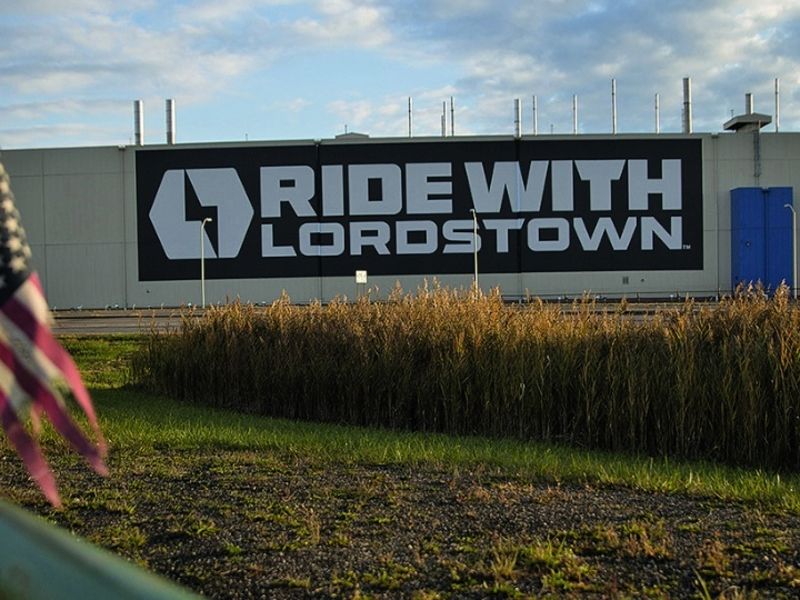
Lordstown Motors Corp. agreed to partner with Foxconn Technology Group in a $280 million deal that has the startup selling its former General Motors factory in Ohio to the Taiwanese company in exchange for cash while also receiving an equity investment.
Under terms of the transaction, Lordstown Motors will sell the Lordstown factory to Foxconn for about $230 million after buying it from GM for just $20 million two years ago. The maker of Apple Inc.’s iPhone will buy $50 million worth of common stock in its new partner and will assemble the Lordstown Endurance electric pickup truck. The deal is contingent on the two sides reaching an agreement on manufacturing the vehicle. Foxconn plans to start mass production in April, according to a person familiar with its schedule.
Lordstown shares were up 4.6 percent in premarket trading Friday. The stock rose 8.4 percent Thursday, closing at $7.98 after Bloomberg had earlier reported a deal was in the works. It was still down 60 percent for the year.
The accord gives both companies something they badly need. Lordstown Motors gets a partner that will hasten the startup’s move into large-scale production, which will help lower the high costs required to make EVs. Foxconn gets a plant in North America where it can build its open-source electric vehicle platform and do contract manufacturing for partners like Fisker Inc.
“It’s less about a facility sale than a strategic partnership,” Lordstown Motors CEO Dan Ninivaggi said in an interview. “You have to find a way to get scale in the auto industry. Foxconn has a vision. They’ve got enormous capabilities in manufacturing and they will be able to fill that plant faster than we could.”
The two companies are working on a manufacturing pact that would agree to a certain cost basis for the Endurance pickup. Lordstown Motors would pay a fee on top of that, Ninivaggi said. Foxconn will make the $50 million equity investment immediately regardless of what happens with talks for an assembly partnership.
The CEO said Lordstown Motors will keep its assembly lines that make the hub motors for each wheel of the Endurance and also the line that assembles the pickup’s battery pack.
Lordstown is racing to get its Endurance pickup into production early next year. Even if the truck is well received by customers, the company won’t fully utilize its Ohio factory anytime soon. So selling the facility and operating in parallel with Foxconn could help the company better leverage the plant where GM employed 10,000 people at its peak.
The company ousted Steve Burns, its founder and CEO, in June over misstatements he made about Endurance orders. Lordstown has repeatedly warned that its status as a going concern is in doubt less than a year after merging with a special purpose acquisition company to go public.
Burns’s successor, Ninivaggi, said in an interview last month that he was looking for partners to help the company take full advantage of a plant that was once the Mahoning Valley’s biggest industrial employer. He added he was exploring all options to raise money.
Lordstown Motors has been under investigations by the U.S. Securities and Exchange Commission and the Justice Department after an internal probe concluded that prior management made inaccurate statements about pre-orders for the Endurance. The company is pushing to start deliveries of the pickup next year.GM’s decision in 2018 to close the plant was a blow to then-President Donald Trump, who a year earlier discouraged rally-goers in the region from selling their homes because of all the jobs he vowed to bring back. Democrats seized on the development as a symbol of unfulfilled promises Trump made to voters in a key battleground state.
Foxconn, meanwhile, is hoping to replicate its smartphone success by building clients’ electric vehicles from the chassis up. It’s rapidly expanding its EV business as major tech companies from Apple to Xiaomi Corp. invest heavily in technologies for next-generation mobility. Over the past year, the Taiwanese company has launched an open EV platform, inked a manufacturing deal with Fisker and formed a partnership with Thailand’s state-owned conglomerate PTT Pcl.
Earlier this year, Chairman Young Liu of Foxconn’s flagship unit, Hon Hai Precision Industry Co., said the company was considering creating an EV manufacturing facility in Wisconsin as its first U.S. automotive outpost. With Foxconn bulking up its automotive muscle, it’s seen as a contender in the race to make EVs for Apple.
The company has had a controversial history of bringing its manufacturing capabilities to the U.S. It originally committed to investing $10 billion in a Wisconsin facility in exchange for billions of dollars in possible subsidies, a project championed by then-President Trump. That vision was never realized, and Liu said earlier this year he’s trying to figure out what to make at the location.
Foxconn will rely on Ohio as its main EV manufacturing base in North America, while the company will still continue to invest in Wisconsin as a key site for tech products, according to a person familiar with the plans.
One of the projects Foxconn will build at the Lordstown plant is Fisker’s Project Pear, which stands for Personal Electric Automotive Revolution, company CEO Henrik Fisker said in an interview. That model is scheduled to start production in the first quarter of 2024 with a minimum planned production of 150,000 vehicles a year, eventually scaling up to 250,000 annually, he said.
Fisker’s CEO said he doesn’t want to reveal too much about the design of his company’s Project Pear except to say that it will target young urban dwellers and sell at a starting price under $30,000.
“It doesn’t have a normal trunk or hatch,” he said. “It’s basically trying to come up with a really cool vehicle that could excite the new generation of buyers, but it fits in their lifestyle and budget. It would take people out of a Toyota Prius or BMW X1.”

